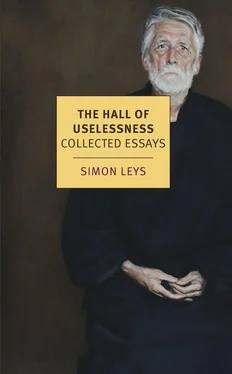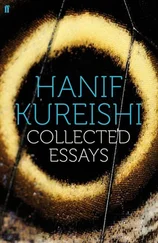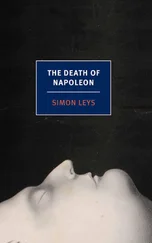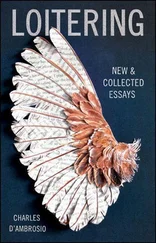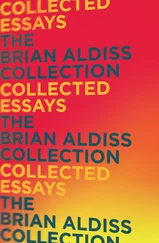It is in the art of painting that the concept of qi found some of its most obvious applications; yet in literature it plays a role that is no less important. Han Yu (768–824) described its operation with a striking image: “ Qi is like water, and words are like objects floating on the water. When the water reaches a sufficient level, the objects, small and big, can freely move; such is the relation between qi and words. When qi is at its fullness, both the amplitude and the sound of the sentences reach a perfect pitch.”[15] As we can see, the qi of literature is essentially the same as the qi of painting: in both arts, it is an energy that underlies the work, endowing it with articulation, texture, rhythm and movement. (Flaubert, labouring on Madame Bovary , was precisely seeking to let this invisible yet active current pass through his book, as it was only this inner circulation that could bring breath and life to the words, sentences and paragraphs and make them cohere; as he himself wrote, one must feel in a book “a long energy that runs from beginning to end without slackening.”[16])
It should be noted, incidentally, that the action of qi can be observed nowhere more clearly than in these purely imagist verses (two examples of which were given above), where syntax completely disappears and grammatical connections dissolve. There we see the fleet of words, all moorings having been cast loose, which is set unanimously in motion; the swell, rocking them on a common rhythm, alone ensures their cohesion.
For any artist, whether a painter or a poet, it is thus imperative that he be able first and foremost to grasp and nurture qi , and to impart its energy to his own creation. If his works are not vested with this vital inspiration, if they “lack breath,” all the other technical qualities they may present will remain useless. Conversely, if they are possessed of such inner circulation, they may even afford to be technically clumsy; no formal defect can affect their essential quality. Hence, also, the first task of a critic will be to gauge the intensity of qi expressed in any given work of art.
The unique emphasis put on the expression of qi has important consequences: originality and formal invention are not valued per se . So long as the artist is able to transmit qi , it is quite irrelevant whether the formal pretext of his work is original or borrowed. Theoretically, one can conceive of a copy that may be superior to its model, to the extent that it succeeds in injecting more qi into its borrowed composition.
Primacy of expression over invention is thus a fundamental aspect of Chinese aesthetics. The best example can be found in calligraphy,[17] which — as everyone knows — is considered in China as the supreme art of the brush. No other art is more narrowly governed by formal and technical conventions, leaving less room to the artist’s imagination and initiative: not only are calligraphers not allowed to invent the form of any written character, but the number of brushstrokes and the very order in which the brushstrokes must follow each other are rigorously predetermined. On the other hand, paradoxically, calligraphy is also the art that can afford an individual with the greatest scope to display in a direct and lyrical way his unique personality, mood and temper, and all the subtle, intimate nuances of his sensibility.
A similar phenomenon is to be found in painting and in poetry. For a layman, at first sight, Chinese painting may appear rather limited and monotonous; landscapes, for instance, are invariably built on a combination of mountains and rivers, organised on the basis of a few set recipes. These stereotyped formulas are themselves filled with conventional elements — trees, rocks, clouds, buildings, figures — whose treatment is standardised in painting handbooks that are straightforward catalogues of forms. The range of poetry is equally narrow: it uses a rigidly codified symbolic language, a set of ready-made images (the song of the cuckoo that makes the traveller feel homesick; the wild geese that fail to bring news from the absent lover; the east wind with its springtime connotations; the west wind and the funereal feelings of autumn; mandarin ducks suggesting shared love; ruins of ancient monuments witnessing the impermanence of human endeavours; willow twigs exchanged by friends as a farewell present; moon and wine; falling flowers; the melancholy of the abandoned woman leaning on her balcony). In a sense, one could say that Chinese poetry is made of a narrow series of clichés embroidered upon a limited number of conventional canvases. And yet such a definition, although it would be literally accurate, would nevertheless miss the point; a deaf man could as well describe a Bach sonata for cello as a sequence of rubbings and scratching effected upon four gut-strings stretched over an empty box.
Poetry is, of course, untranslatable by its very nature; in the case of Chinese poetry, however, this impossibility is further compounded with a basic misunderstanding. Here, indeed, translation operates like a perverse screen that saves the chaff in order to eliminate the grain. What the translator offers to the reader’s admiration is precisely the least admirable part of the poem: its subject matter (generally trite) and its images (borrowed, nine times out of ten, from a conventional catalogue and hence utterly devoid of originality). The specific quality of the poem necessarily escapes the translator, since (as is also the case with painting and calligraphy) it does not reside in a creation of new signs, but in a new way of using conventional signs . For a poet, the supreme art is to position, adjust and fit together these well-worn images in such a way that, from their unexpected encounter, a new life might spark.
In this sense, one should say that in Chinese art, the emphasis is always on interpretation rather than on invention . “Interpretation” should be understood here in the musical sense of the word. Ivan Moravec, let us say, is not a lesser artist for not having himself composed the Chopin nocturnes that he interprets. And yet, it is through the very fidelity of his interpretation that he manages to express his own individuality and sensibility. It is his creative genius that is different from the one of Claudio Arrau, or of any other musician interpreting this same piece. By narrowing the field of its invention, an art intensifies the quality of its expression —or rather, it shifts creation from the first arena to the second. (Actually, this axiom has a validity that goes beyond Chinese aesthetics: see, for instance, in modern European art the beginnings of Cubism. For Braque, Picasso and Gris, the world suddenly seemed to shrink to the mere dimensions of a guitar, a newspaper and a fruit dish — the very conventions that freed these artists from the need to define a new subject matter allowed them to concentrate entirely on the problem of elaborating a new language. Earlier, one mountain and twelve apples had already fulfilled the same function for Cézanne.)
For a painter or a poet, the question is not how to eliminate stereotypes, but how to handle them in such a way that, through the stereotypes, the “current” may flow. Under the efficient power of qi , a conventional mountain-and-water combination can then become a microcosmic creation, the worn-out image of falling flowers can turn into a poignant and universal metaphor of fate, and the old cliché of the abandoned woman on her balcony becomes an effective summing-up of the entire human condition.
THE POWER OF EMPTINESS
Earlier, we pointed out that in Chinese philosophy the Absolute only manifests itself “in hollow”: only its absence can be circumscribed. We met a first important application of this conception in the precept that recommends the painter always reveal only half of his subject in order to better suggest its totality. Not only can the message reach its destination without having to be fully spelled out, but it is precisely because it is not fully spelled out that it can reach its destination. In this sense, the “blanks” in painting, the silences in poetry and music are active elements that bring a work to life.
Читать дальше
